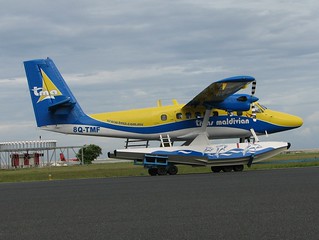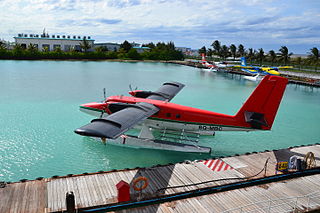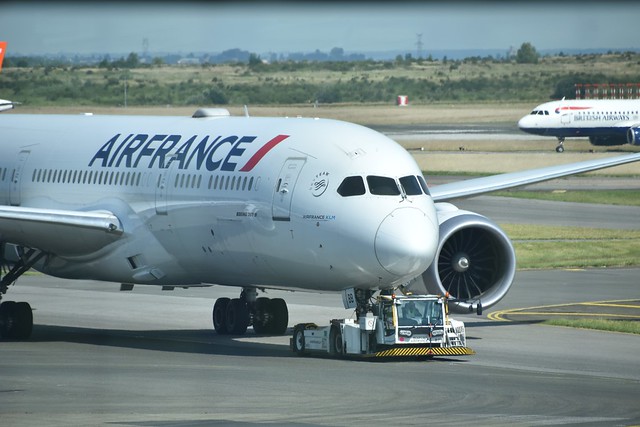TMA DHC6 at Vommuli on May 16th 2023, wing strike with water
Last Update: April 30, 2024 / 17:46:12 GMT/Zulu time
Incident Facts
Date of incident
May 16, 2023
Classification
Accident
Airline
TMA Trans Maldivian Airways
Departure
Aluvifushi, Maldives
Destination
Vommuli, Maldives
Aircraft Registration
8Q-TAQ
Aircraft Type
De Havilland DHC-6 Twin Otter
ICAO Type Designator
DHC6
Maldives CAA released their preliminary report summarizing the sequence of events:
The flight from IVL to VOM was uneventful until the initial touch down on water.
The crew did a circuit to conduct a visual check of the landing area and then decided to land parallel to the waves and continued the approach. The PIC estimated the wind was from 280° at a speed of approximately 10 knots.
During landing, the aircraft impacted a swell, resulting in a bounce that led to the LH wing drop and the wing contacting with the water. Immediately after the aircraft came to a stop, the crew checked for any damages and found the damaged LH wing was damaged.
The aircraft taxied and docked on the fixed platform and shutdown both engines. The passengers then disembarked through the main airstair door.
On Apr 30th 2024 the CAA released their final report concluding the probable causes of the accident were:
The AICC determines that the probable causes of the accident were:
1. The aircraft inadvertently hit a swell during landing.
2. Limited experience of the PF to operate to Category C water aerodromes.
3. Complacency and lack of vigilance on the part of PM to closely monitor the situation and take over when necessary.
4. Non-conducive power management for the aircraft behaviour during a bounce.
The AICC/CAA analysed:
In general, wind direction and strength may be difficult to gauge in the absence of an appropriately located windsock, especially where local geography may affect the winds in the landing area. At the time of the landing at Vommuli, the wind was westerly with an estimated speed of 10-15 knots with high swells. During westerly winds, landing areas surrounding Vommuli island experiences wave heights of two to three feet with roller waves, typical for the time of the year. The waves move into the atoll from the north-west and passes through the atoll in a south easterly direction.
While these waves flow between the two islands - Dhoores and Vommuli, the waves create unpredictable, multi–directional swell patterns. Another peculiar feature of these waves is that they have unusually long swell distances.
The PIC was familiar with the VOM landing areas and stated that the water conditions at VOM was ‘nice’ and way better than the previous two days, and this is one reason why the PIC decided to let the FO land.
Crew Co-ordination during Landing & Aircraft Handling
The accident sector was flown by a qualified FO, but having limited experience in landing under the prevailing water conditions. The PIC (a Line Training Instructor) stated that both crews discussed and selected the most suitable landing line which was towards the edge of the Vommuli island reef. As required by the procedures in the TMA Operations Manual, Part A, the aircraft performed a flyover inspection to assess the aerodrome surface conditions prior to landing.
The crew interviews confirm that the required landing checks were carried out including the selection of the flaps. It was noted that the aircraft was relatively lightweight and as per checklist the ref speed (Vref) was less than 70 knots. Both crew members confirmed that the FO briefed the PIC on the landing and that the PIC advised the FO to amend the landing direction and the way to approach for landing.
Hence, the FO was briefed to go to the west on quartering the wind (from the right) paralleling the swells. The PIC stated that this instruction was given to avoid landing head-on (perpendicular direction) due to the large gaps between the swells, as it was the best option under the given water conditions.
The direction of landing was westbound, aiming towards the tip of the lagoon on Vommuli island, and not directly towards Vommuli island. This was to ensure that the go-around path was maintained clear, and Vommuli island will be on the right, in the event a go-around becomes necessary.
The PIC advised FO to land parallel to the waves and continued a normal approach.
During landing, with reduced power, the aircraft hit a swell and bounced. After the bounce, the aircraft experienced a left bank with the left wing impacting the water.
Immediately after the bounce the PIC instructed FO to add power. Following up, the FO stated that the power levers were moved FWD to add power. However, the FO felt the power was insufficient due to the delay in engine spooling up and the aircraft continued to yaw to the left. The PIC took control, recovered and landed the aircraft.
It is noted that the PIC and FO statements contradict each other regarding power management. While the FO stated that the power levers were moved forward to add power as advised by the PIC, the PIC stated that the power levers were retarded instead of moving forward, thus reducing the power. The PIC further stated that he added power after taking over the controls, but the aircraft did not respond fast enough due to the lag in engine spooling.
When asked, the PIC stated that the PF was competent to land under the
circumstances and would let the PF land again, under similar circumstances if the opportunity arises. The PIC added that the lesson learnt was to be more vigilant and prepared to take over from the PF, when needed.
Incident Facts
Date of incident
May 16, 2023
Classification
Accident
Airline
TMA Trans Maldivian Airways
Departure
Aluvifushi, Maldives
Destination
Vommuli, Maldives
Aircraft Registration
8Q-TAQ
Aircraft Type
De Havilland DHC-6 Twin Otter
ICAO Type Designator
DHC6
This article is published under license from Avherald.com. © of text by Avherald.com.
Article source
You can read 2 more free articles without a subscription.
Subscribe now and continue reading without any limits!
Read unlimited articles and receive our daily update briefing. Gain better insights into what is happening in commercial aviation safety.
Send tip
Support AeroInside by sending a small tip amount.
Related articles
TMA DHC6 at Finolhu on Nov 13th 2021, right wing damage during water takeoff
A TMA Trans Maldivian Airways de Havilland DHC-6-300 Twin Otter, registration 8Q-MBC performing a flight from Finolhu to Male (Maldives) with 15…
Trans Maldivian DHC6 at Medhafushi Island on Oct 22nd 2020, ship strike
A Trans Maldivian de Havilland DHC-6-300, registration 8Q-TMR performing a flight from Male to Medhafushi Island (Maldives) with 14 passengers and 3…
Trans Maldivian DHC6 at Male on Oct 5th 2020, sudden roll to the right and left during water landing
A Trans Maldivian De Havilland DHC-6-300, registration 8Q-TMF performing flight M8-702955 from Vommuli to Male (Maldives) with 11 passengers and 3…
Trans Maldivian DHC6 at Kuredhu Island on Feb 24th 2020, bounced landing, wing tip dipped into water
A Trans Maldivian de Havilland DHC-6-300, registration 8Q-MBC performing a charter flight from Male to Kuredhu Island (Maldives) with 15 passengers…
Trans Maldivian DHC6 at Rangali on Jul 9th 2012, float collapsed
A Trans Maldivian Airways de Havilland Dash 6-300 Twin Otter, registration 8Q-TMT performing a flight from Male to Rangali Island Conrad Resort…
Newest articles
France B789 near Iqaluit on May 7th 2024, burning odour on board
An Air France Boeing 787-9, registration F-HRBB performing flight AF-338 from Paris Charles de Gaulle (France) to Seattle,WA (USA) with 260 people on…
West Atlantic AT72 at East Midlands on Jan 17th 2023, electrical issues
A West Atlantic Avions de Transport Regional ATR-72-200, registration G-NPTF performing flight NPT-07C from Belfast International,NI to East…
Subscribe today
Are you researching aviation incidents? Get access to AeroInside Insights, unlimited read access and receive the daily newsletter.
Pick your plan and subscribePartner

A new way to document and demonstrate airworthiness compliance and aircraft value. Find out more.

ELITE Simulation Solutions is a leading global provider of Flight Simulation Training Devices, IFR training software as well as flight controls and related services. Find out more.

Your regulation partner, specialists in aviation safety and compliance; providing training, auditing, and consultancy services. Find out more.
AeroInside Blog
Popular aircraft
Airbus A320Boeing 737-800
Boeing 737-800 MAX
Popular airlines
American AirlinesUnited
Delta
Air Canada
Lufthansa
British Airways




